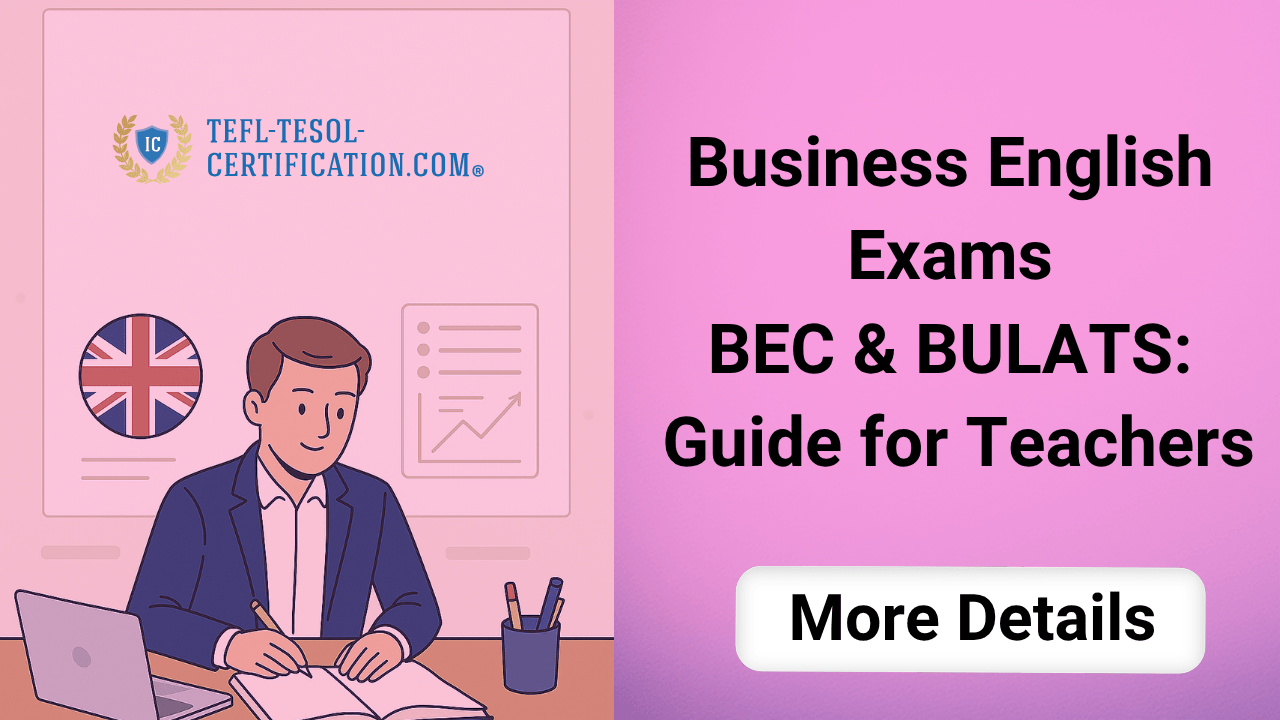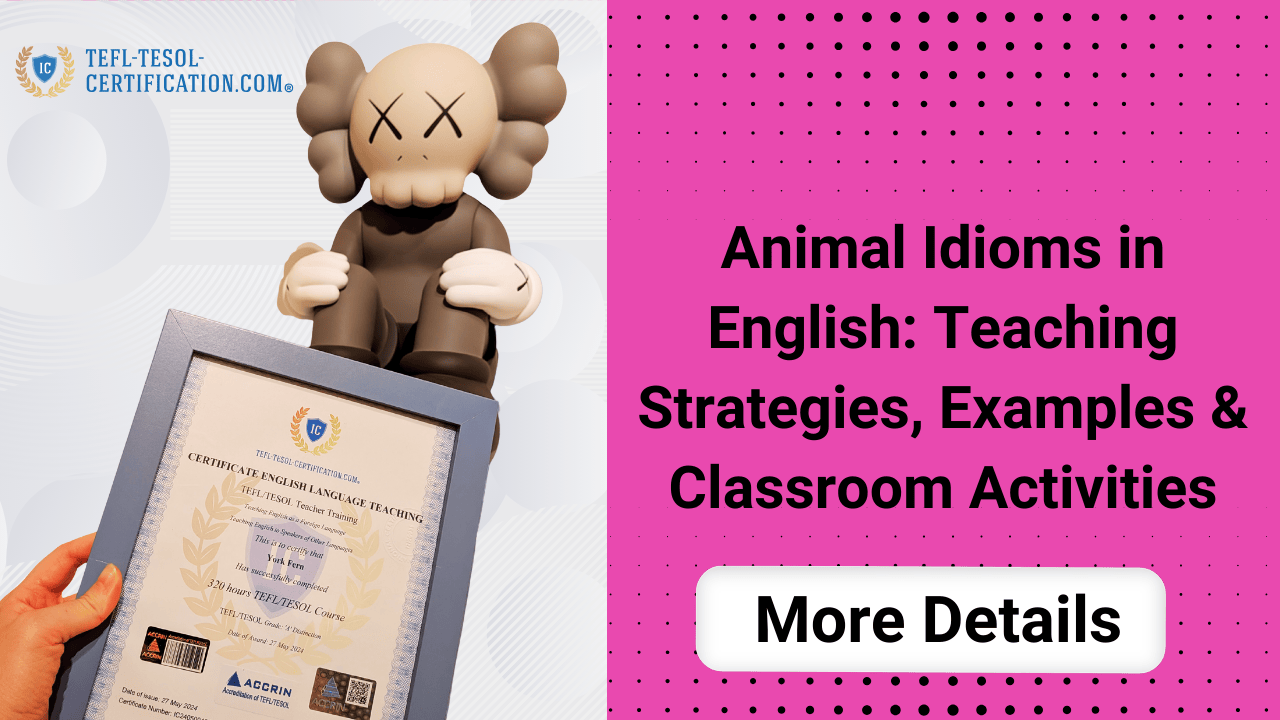💡 Unlock the secrets to doubling your teaching income with our exclusive checklist! 🎯 This checklist is designed for English teachers who want to 📈 attract more students and 🔥 keep them engaged for the long term.
Table of contents
- Business English exams: why they matter for English teachers and trainers
- BEC exam structure: levels, papers and how to explain it to students
- BEC preparation: a 12-week training roadmap for teachers
- Reading skills for BEC: skimming, scanning and smart strategies
- Writing for BEC: emails, reports, proposals — structure is everything
- Listening for BEC: noise, accents and note-taking
- Speaking for BEC: partners, roles and pacing
- Typical BEC mistakes — and how teachers can fix them
- Preparing for BULATS-style testing: modular focus and insider tips
- Teacher toolkit: TEFL/TESOL as your methodological foundation
- Lesson plan idea: one-week mini-syllabus around the BEC structure
- Assessment and scores: explaining BEC to adult learners
- Motivation and mindset: small rituals, big impact
- My practical toolkit for every Business English exam course
- Readiness checklist: is your student exam-ready?
- Mini task analyses: from mistake to improvement
- Fast FAQ for teachers: quick answers in under a minute
- For teachers who are just starting with Business English exams
- Conclusion: what to tell a colleague over that quick coffee
Business English exams such as BEC (Business English Certificate) and BULATS (Business Language Testing Service) are international tests that measure how confidently candidates can use English in professional and corporate contexts. They are especially relevant for learners who work or plan to work in international companies, run their own business, study business or management, and want an official certificate proving their level of Business English.
In this article, we will look at the structure and levels of the BEC exams, discuss how they relate to modern BULATS-style testing, and, most importantly, focus on how English teachers can build effective training programmes that help adults pass these exams and use Business English at work.
Business English exams: why they matter for English teachers and trainers
English teachers play a central role in Business English exam preparation. Your job is not just to run students through practice tests but to build a training system that reflects real career goals, company requirements and the current level of each learner. For some students the exam is a step towards a promotion, for others it is part of a corporate assessment, and for some it is a ticket to relocation.
- Who needs Business English exams? HR teams and team leaders use them to benchmark staff, freelancers use certificates to strengthen their portfolio, and teachers add “BEC / BULATS exam preparation” to their CV and marketing.
- How is Business English different from General English? It is all about topics, genres and roles: emails, memos, reports, meeting notes, negotiations, decisions and problem-solving tasks in Speaking.
- What does the teacher get? A clear syllabus, predictable outcomes and a powerful way to position services: “I help professionals pass Business English exams and use English at work with confidence.” 🎯
BEC exam structure: levels, papers and how to explain it to students
When a new corporate client comes to me, the conversation is usually short and practical: “We need B2 for our product managers. What can we do with BEC?” My answer is simple: “Let’s look at the format first: Reading, Writing, Listening and Speaking, roughly 25% each. Then we map your team’s skills to these papers and build a timetable.”
To avoid overwhelming students with details, I keep a simple overview at hand. It helps both the client and the learner understand what exactly they are preparing for and where to focus their energy.
| Level | Official name | Papers | Approx. time | Trainer’s comment |
| B1 | Business Preliminary (formerly BEC Preliminary) | Reading & Writing; Listening; Speaking | ~90 min; ~40 min; ~12 min | Great starting point for assistants, junior staff and interns. |
| B2 | Business Vantage (BEC Vantage) | Reading; Writing; Listening; Speaking | ~60 min; 45 min; ~40 min; ~14–16 min | Typical for mid-level professionals in marketing, sales and management. |
| C1 | Business Higher (BEC Higher) | Reading; Writing; Listening; Speaking | ~60 min; ~70 min; ~40 min; ~15–16 min | For senior managers and experts; strong focus on reports and proposals. |
It is important to emphasise that BEC is about performing in real work situations, not about memorising rare business vocabulary for its own sake. Students feel much more motivated when we connect each paper to concrete workplace tasks: “email to a client”, “brief for your team”, “short persuasive pitch”, “progress report for your manager”.
- Reading: quickly extracting facts and conclusions from email chains, reports and short business articles.
- Writing: concise, purposeful emails and clearly structured reports with a professional but friendly tone.
- Listening: meetings, presentations, conference calls and interviews, with different accents and background noise.
- Speaking: pair interaction: exchanging views, negotiating options, making joint decisions and delivering a short presentation.
BEC preparation: a 12-week training roadmap for teachers
A format I often use is a “12-week plan with 3 progress checkpoints”. It works for groups and one-to-one students. The secret is simple: every classroom skill is linked back to a real business context.
- Diagnostics and needs analysis (Week 1): quick placement test plus “collecting artefacts”: real emails, slides, internal reports. This becomes your personalised topic bank.
- Core skills skeleton (Weeks 2–4): one priority skill per week: skimming/scanning for Reading, email/report structure for Writing, concise note-taking for Listening, turn-taking and signposting for Speaking.
- Genre module (Weeks 5–8): practice key business genres: memo, email, report, proposal. Each genre gets a template plus a case study from the learner’s own industry.
- Exam simulations (Weeks 9–11): at least two full mock exams with a timer, answer sheets and an error checklist.
- Final polishing (Week 12): individual “weak spots”: timing, pronunciation, pacing, breathing, small confidence rituals before the Speaking test.
- Tools: shared documents for collaborative editing, a simple timer, and background office noise to train Listening under realistic conditions.
- Materials: anonymised real emails, internal presentations, KPI reports and meeting notes. This creates a ready-made content pool for personalised lessons.
Example from my practice: a marketing team from a tech start-up prepared for B2. We replaced textbook texts with real emails from their CRM and turned the collaborative Speaking task into a discussion of their actual product roadmap. On exam day the tasks felt familiar and the rhythm felt natural — that confidence made a visible difference to their scores.
And start earning money 💸 by teaching English in your own country, abroad, or online from anywhere on the planet! 🎁 Gifts and bonuses: professional support from your personal coach 🧑🏫 and job placement assistant 💼.
Reading skills for BEC: skimming, scanning and smart strategies
For Business English exams, one of the biggest challenges for adult learners is time. Reading tasks demand both speed and accuracy. Two core techniques you will teach again and again are skimming and scanning.
Skimming means reading quickly to get the overall idea: topic, structure and writer’s main point. Students do not focus on every word; instead, they learn to identify the purpose of the text and the general message.
Scanning is selective reading for specific information: dates, figures, names, key facts. This strategy is crucial for tasks where learners have to find a small detail in a longer text under time pressure.
Good exam preparation helps students combine skimming and scanning so they save time and still answer accurately.
- “Three-layer” technique: 1) headings and topic sentences; 2) signal words (however, therefore, figures, deadlines); 3) checking for traps in the questions.
- Answer sheet discipline: encourage transferring answers immediately, not at the last minute. It saves both time and nerves.
- Business collocations focus: teach vocabulary in chunks: revenue grew, negotiate terms, meet the deadline, handle complaints, rather than isolated words.
Reading homework ideas: subscribe to industry newsletters, read executive summaries, and do 10-minute timed reading sprints on weekdays. Quick visible progress is highly motivating for busy professionals 🚀.
Writing for BEC: emails, reports, proposals — structure is everything
At the Writing stage, your main goal as a trainer is to give students clear structures they can rely on under exam pressure. A simple winning formula for any business text includes three elements: clarity of purpose, logical structure and appropriate tone.
At B2 and C1 level, learners are usually asked to produce two types of text: a short internal message (for example, an email to a colleague or a notice) and a longer piece such as a report or proposal. Many teachers use paragraph-based templates that show exactly how to organise the text: introduction, development, conclusion and recommendations.
Over time, students move from “fill the template” writing to more independent and confident production. The key is to make the template a support, not a cage.
- Email (80–120 words): greeting → context → action points → closing. No unnecessary phrases, no over-formal clichés.
- Report/Proposal (around 180–200+ words): title → background → findings → recommendations → next steps. Headings and numbered sections help both the writer and the examiner.
- Lexis: prioritise precise, neutral verbs over buzzwords: consider, outline, confirm, allocate, review.
- Grammar as a tool: conditionals for decisions and consequences, passives for formal reports, gerunds for processes and actions.
Listening for BEC: noise, accents and note-taking
In real-life meetings there is always some background noise: air conditioning, keyboard clicks, people moving around. I sometimes leave that noise in deliberately when practising Listening. The goal is to prepare learners for reality, not for a perfect recording.
We also work with different accents: British, European, Asian and others that learners might realistically hear in international companies. For note-taking we use symbols, arrows, percentages and initials instead of full sentences.
- Before the first listening: students predict possible answers from the context, pay attention to units of measurement and currencies.
- During listening: they write down only the key information: “Q3 — raise postponed, Q4 — 15% budget cut”, not full sentences.
- After listening: they quickly check whether the numbers and names are consistent and logically connected.
Trainer tip: alternate short and long recordings and, where possible, add real meeting extracts (with permission). This builds resilience to “live” audio and prepares students for authentic business communication.
🚀 More students, 💰 higher income, 🌍 complete freedom! ✅ 112 verified platforms with top rates ⏳ Flexible schedule – work whenever and as much as you want 🎯 Simple requirements – start earning right away 💎 Boost your career and income by teaching students worldwide!
Speaking for BEC: partners, roles and pacing
In the Speaking paper three things matter most: turn-taking, clear structure and collaboration. I train students to “pass the ball”: ask a question, build on a partner’s idea, disagree politely and move the discussion towards a joint decision.
- “ABC” strategy: Answer — give a short answer; Back it up — add an example or data; Connect — invite your partner to respond.
- Useful phrases: In my view…, What if we…, Let’s prioritise…, Shall we agree on…
- Tempo: around 120–140 words per minute in a mini-monologue; pauses are your friend, not your enemy.
Typical BEC mistakes — and how teachers can fix them
- Over-complicating the language. Examiners value clarity. Cut empty phrases, avoid jargon, keep verbs active and direct.
- Ignoring timing until the last minute. Use a timer from Week 1. Time awareness reduces stress more than any “exam tips”.
- Treating the Speaking partner as a competitor. The test is cooperative. Train students to ask questions, hand over turns, and use “soft disagreement”.
- Learning vocabulary as a random list. Teach collocations and functional chunks: negotiate a contract, meet objectives, raise an invoice, handle a complaint.
Preparing for BULATS-style testing: modular focus and insider tips
Historically, BULATS tested Business English in modules: Reading and Listening online, Speaking and Writing separately. This logic is still useful for corporate clients today, especially when a company wants to check specific skills quickly or upgrade writing to a certain standard.
- Exam tips for BULATS-type tests: keep a modular focus, train reading speed and accuracy, and adapt writing tasks to the company’s real templates and tone of voice.
- Adaptive training: mix easier and more difficult texts from time to time — many modern tests adjust difficulty based on previous answers.
- Teacher portfolio: show clients a sample roadmap: for example, four weeks for Reading/Listening plus two weeks for Writing/Speaking with mini-assessments.
If a client says, “We only have one month,” the answer is simple: “Then we narrow our focus: confirm the current level and strengthen the weakest paper.” A realistic four-week mini-plan usually works better than an over-ambitious full course.
Teacher toolkit: TEFL/TESOL as your methodological foundation
Whatever name a Business English exam has, the most successful trainers are those with a strong methodological base. TEFL and TESOL training provide exactly that foundation: lesson planning, clear objectives, assessment strategies and constructive feedback techniques.
If you feel there are gaps in your toolkit — for example, in teaching writing, classroom management online, or CLIL-style lessons — specialised TEFL/TESOL modules can help you close them and give you extra confidence when working with corporate clients and exam-oriented groups.
Lesson plan idea: one-week mini-syllabus around the BEC structure
- Monday – Reading: three short texts plus one longer text; focus on cross-referencing, cohesive devices and timing.
- Tuesday – Writing: a 100–120-word email with a checklist: purpose, structure, tone, verbs.
- Wednesday – Listening: a meeting plus a short presentation; note-taking and number checking.
- Thursday – Speaking: pair problem-solving with roles, for example “analyst” and “manager”.
- Friday – Mixed practice: mini mock exam with a timer, error review and a small weekend homework task.
After 8–12 such cycles, students gain more than “exam knowledge”: they develop sustainable work habits in English. The exam result becomes a natural by-product of systematic practice.
Assessment and scores: explaining BEC to adult learners
I often explain it this way: “Each paper counts for roughly 25%. A weak paper can be balanced by a stronger one, but if you fail in two sections, the third will not save the result.” Then we look at the descriptors — Content, Communicative Achievement, Organisation, Language — and relate them to the learner’s actual job KPIs.
- Writing rubrics in practice: is the task fully achieved? is the text easy to read? is the register appropriate? do vocabulary and grammar support the message?
- Speaking assessment: contribution to the conversation, ability to negotiate and clarity of arguments all push the score up.
Motivation and mindset: small rituals, big impact
- Start ritual: five minutes of silent reading at the beginning of the lesson; it helps the brain switch into English mode.
- Focus ritual: a simple Pomodoro timer plus a “lesson goal” card on the desk.
- End ritual: finish every lesson with one “micro-victory”: a fixed paragraph, a clear formula, or a new useful phrase. 😊
Doubt is normal — for students and for us. I still feel a little nervous when a new group does their first full mock exam. But once I hear a confident “Shall we prioritise the clients who…”, I know the system is working.
My practical toolkit for every Business English exam course
- Time-management tricks: separate timers for reading, listening and answer transfer; a “minutes → tasks” table for each paper.
- Genre templates: one sheet for emails, one for reports, one for proposals. At the top — paragraph structure; at the bottom — overused phrases and stronger alternatives.
- Collocation lists by industry: IT, finance, marketing, logistics and others. Add 10–15 new collocations per week.
- Speaking communication cards: how to ask for clarification, how to disagree politely, how to guide the partner towards a decision.
- Self-check sheets: a quick “traffic light” system: green — confident, yellow — unsure, red — needs more practice.
These simple tools give students a sense of control and give you, as a teacher, a clear metric of progress: from week to week more “red” areas turn yellow and then green.
Readiness checklist: is your student exam-ready?
- They can describe the BEC structure at their level (B1/B2/C1) out loud, without notes.
- They complete Reading tasks on time and transfer answers correctly.
- They can write two genres to a high standard: an email and a report/proposal.
- They catch key numbers, dates and names in Listening and can cope with different accents.
- In Speaking, they cooperate: ask questions, agree/disagree and summarise decisions.
- They have a set of “emergency phrases” for clarification, reformulation and buying time.
Print this checklist on card or thicker paper. A week before the exam, go through it together and mark what is ready and what still needs attention.
Mini task analyses: from mistake to improvement
Reading – Matching headlines. Typical problem: learners choose the first seemingly correct option and stop reading. Solution: “two-proof rule” — the headline must match both the topic sentence and one key phrase in the middle of the paragraph.
Writing – Report. Typical problem: long, vague paragraphs. Solution: “three-sentence sections”: fact → analysis → recommendation, around 60–70 words max.
Listening – Multiple choice. Typical problem: getting lost in the options. Solution: cross out clearly wrong options before listening and check numbers and names afterwards.
Speaking – Collaborative task. Typical problem: two parallel monologues instead of a dialogue. Solution: “three-step rule”: answer → question back to partner → joint conclusion.
Fast FAQ for teachers: quick answers in under a minute
- How many hours are needed for preparation? For a solid B2 I usually plan 60–80 hours including homework; for C1, around 90–120. Intensive formats are possible, but there are no magic shortcuts.
- Which coursebooks should I choose? Use one or two coursebooks as a backbone and cover the rest with authentic company materials. The book provides structure; real life adds substance.
- Do students need “fancy” words? They need accurate ones. Instead of “utilise”, use “use”; instead of “commence”, say “start”. Exams reward clarity, not pretentious language.
- How do I measure progress? Look at real artefacts: emails with minimal correction, stable timing, confident pair work and a clear improvement in mock exam scores.
For teachers who are just starting with Business English exams
If you are new to Business English exam preparation, do not try to cover everything at once. Choose one level (for example, B1) and one writing genre. Design ten lessons around that focus, keep a detailed error log and create a mini before/after portfolio. Then gradually add B2, Speaking and Listening. Your methodology will grow in layers, just like a well-structured business report.
And do not forget your own foundation. A solid TESOL qualification gives you the principles of teaching English as a second language; a good TEFL course shows how to turn those principles into practical classroom decisions. These are not just lines in a CV — they are the tools that make your Business English exam courses effective and scalable.
Conclusion: what to tell a colleague over that quick coffee
BEC preparation is not about “teaching to the test”. It is about building core workplace skills: reading fast, writing clearly, listening accurately and speaking to the point. BULATS-style preparation, with its modular logic, is about flexibility and focusing on what the company truly needs.
Take one or two ideas from this article, test them in your next lesson and watch how your learners respond. Then scale what works. In exam preparation, simple, consistent systems usually win over complicated theory 🚀.
Terms used:
EFL, ESL, TEFL, TESOL

York Fern
An English instructor with 12+ years of experience. I work for an online school and travel the world, teaching students from various countries, leveraging my TEFL/TESOL certification. Seeing the world's oceans, mountains, and cities with my own eyes has given me a profound appreciation for the importance of quality education and international communication.
and start earning by teaching English in your country, abroad, or online from anywhere in the world! Order the course with a 50% discount 💸 and receive as a gift the support of a personal coach 👨🏫 and job placement assistant! 🎁🚀 Hurry, limited spots available! 🏃♂️💨
💡 Unlock the secrets to doubling your teaching income with our exclusive checklist! 🎯 This checklist is designed for English teachers who want to 📈 attract more students and 🔥 keep them engaged for the long term.
🚀 More students, 💰 higher income, 🌍 complete freedom! ✅ 112 verified platforms with top rates ⏳ Flexible schedule – work whenever and as much as you want 🎯 Simple requirements – start earning right away 💎 Boost your career and income by teaching students worldwide!
choose us?




